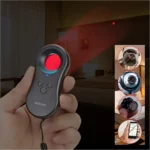Video doorbells have become an increasingly popular home security upgrade, providing homeowners with visibility into who is at their door anytime from anywhere. But many traditional video doorbells still require physically pressing a button to activate the camera and communicate.
Touchless video doorbells take things to the next level by removing the need for any physical contact at all. But what exactly are the benefits of upgrading to a touchless, hands-free video doorbell? This comprehensive guide will explore the key advantages to help you determine if going touchless is right for enhancing security and convenience in your home.
What is a Touchless Video Doorbell?
First, let’s briefly look at what makes a video doorbell “touchless”. Touchless doorbells remove the need to physically press a button to trigger the doorbell camera and enables hands-free communication.
Instead, advanced proximity sensors and motion detection activate the camera automatically when someone approaches your door. Some systems enable truly hands-free two-way talk without needing to push a button to speak.
Common features of touchless video doorbells include:
- Motion-activated camera and alerts
- Hands-free two-way audio communication
- Wireless connectivity and battery power
- Smartphone app for remote access
- Compatibility with smart home platforms

Touchless video doorbells activate automatically when motion is detected.
Now let’s dive into the specific benefits that touchless operation enables.
1. Enhanced Home Security
Like traditional video doorbells, touchless systems provide a huge convenience and security benefit by giving you on-demand visibility into your front door from anywhere. Motion-activated alerts allow you to spot approaching visitors and potential intruders.
But touchless operation delivers even more security advantages. Since the doorbell isn’t visible, potential intruders have no indication they are being recorded, making them less likely to cover up or look away. And hands-free audio allows you to warn off intruders without them realizing you aren’t home.
2. Smart Human Detection
Advanced AI built into touchless doorbell cameras enables smart human detection that reduces false alerts. The system learns to recognize faces and differentiate between human movement and other motion like passing cars or animals.
You’ll only get notified when a person is detected at your door, cutting down on disruptive alerts. Person detection features can often differentiate familiar faces like family members too.
3. Convenience and Control
Answering the door is always disruptive. With a touchless smart doorbell, you can screen visitors conveniently from anywhere via smartphone without needing to go to the door.
Two-way talk enables you to communicate with delivery people, visitors or even family members at your doorstep directly from your phone. Authorized visitors can be granted secure access codes to open the door remotely too.
And of course, full integration with smartphones and smart speakers allows for convenient hands-free voice control. You can pull up the doorbell camera feed and communicate by simply asking Alexa or Google Assistant.
4. Hygiene and Hands-Free Operation
In the age of heightened public health awareness, touchless operation helps reduce contact with frequently touched surfaces to prevent the spread of germs.
According to a study published in BMC Infectious Diseases, human coronaviruses like the one that causes COVID-19 can persist on surfaces like metal, glass, and plastics for up to 9 days [1]. Frequently touched surfaces are prime locations for viral transmission.

Touchless operation prevents hand contact with frequently touched surfaces.
With touchless doorbells, occupants never need to make direct contact with the doorbell button, keeping hands clean and germ-free. The hands-free experience provides significant peace of mind.
During flu season or a public health scare, limiting contact with the high-touch surfaces at your front door is an important way to reduce infectious disease risks. Touchless smart doorbells enable this.
How to Choose the Right Touchless Video Doorbell
Upgrading to a touchless video doorbell is a smart decision, but many options exist on the market. Here are some key factors to consider when selecting the right system:
Image Quality and Advanced Features
Crisp high definition video should be a minimum requirement to get a clear view of visitors. Look for doorbell cameras that support at least 1080p HD recording. Models with advanced night vision, HDR imaging, and zoom also provide visibility in any lighting conditions.
Other useful features include built-in Alexa integration, smart motion detection, silenced modes, and smart alerts that differentiate between people, vehicles, animals, and packages.
Wireless Connectivity and Power
For easiest possible installation, look for completely wireless video doorbells that connect to your home’s WiFi network and are powered by built-in rechargeable batteries.
This avoids the need for any wiring or electrical work during installation. However, note that fully wireless models will need periodic battery charging.
Smart Home Integration
Choose a touchless doorbell camera that integrates seamlessly with other smart devices you have. Look for compatibility with Apple HomeKit, Amazon Alexa, Google Assistant, Samsung SmartThings, and other platforms.
The ability to pull up doorbell alerts on smart displays, use convenient voice controls, and integrate with other security cameras are major benefits. Having a unified smart home is ideal.

Touchless doorbells integrate with voice assistants and smart home platforms.
Weather and Impact Resistance
Since doorbells are exposed outdoor elements, they need to withstand the elements in any climate. Ensure the model you choose is rated for weather, water, heat, cold, and UV light exposure.
Units with IK08 or higher impact resistance ratings help the doorbell withstand accidental bumps and kicks without damage during use or installation.
Installation Process
Look for touchless doorbell systems that don’t require wiring or electrical expertise to install. Wireless and battery-powered models usually can replace existing doorbells in minutes with just simple tools for drilling and mounting.
Easy DIY installation means you can upgrade to touchless convenience faster without the hassle and expense of hiring an electrician.
Warranty Coverage
Given the investment into smart home security gear, opt for video doorbells that come with strong product warranties of 1 to 3 years in case of any manufacturing defects or technical issues. This provides peace of mind should problems arise.
Budget Considerations
Touchless video doorbells range widely in pricing from about $100 to $250 for top consumer models. High-end commercial systems with advanced technology can cost over $500.
For most homeowners, we recommend sticking to mid-range $150 to $200 options from reputable brands that provide the ideal balance of features, quality, and long-term value. But excellent budget-friendly options also exist, especially if you don’t need every bell and whistle.
Success Stories and Use Cases
Still on the fence about upgrading to touchless? These real-world examples and success stories highlight the benefits:
- Rachel installed a Ring Elite touchless doorbell at her suburban home. With preschool aged children, she loves being able to immediately see and talk to visitors at the door without needing to open it or have the kids touch the doorbell. The enhanced security and germ prevention peace of mind are invaluable.
- James manages an office complex and upgraded the tenant entry system to a commercial hands-free video intercom and access control system. Tenants feel safer entering without touching door handles, and the system provides 24/7 visibility into who is coming and going. He says it was an affordable upgrade that helped attract new tenants.
- Lidia’s elderly parents had trouble hearing visitors at their front door. She set them up with the Nest Hello touchless doorbell system. Now her parents get automatic alerts on their phones whenever someone is at the door and can immediately talk to them through the app without any trouble hearing. This provides significant convenience as their mobility has decreased.
Start Enjoying Hands-Free Convenience
As you can see, touchless video doorbells provide impressive benefits ranging from enhanced security and smart detection to improved accessibility, voice controls, and germ prevention.
Touchless systems eliminate the need to touch frequently used surfaces at your front door, providing effective prevention against the spread of infectious diseases. And automatic motion sensing delivers added security and convenience over traditional doorbells.
Upgrading to touchless can help make your home safer, cleaner, and more accessible. We hope this guide provided useful insights to help find the right smart doorbell camera for your needs and budget.
Have you upgraded to a touchless video doorbell? Share your experiences and insights in the comments below!
Let us know if you have any other questions!


